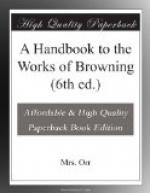“CHILDE ROLAND TO THE DARK TOWER CAME,” describes a brave knight performing a pilgrimage, in which hitherto all who attempted it have failed. The way through which he struggles is unknown to him; its features are hideous; a deadly sense of difficulty and danger hangs over every step; and though Childe Roland’s courage is pledged to the undertaking, the thought of failure at last comes to him as a relief. He reaches the goal just as failure appears inevitable. The plain has suddenly closed in; weird and unsightly eminences encompass him on every side. In one flash he perceives that he is in a trap; in another, that the tower stands before him; while round it, against the hill-sides, are ranged the “lost adventurers” who have preceded him—their names and story clanging loudly and more loudly in his ears—their forms revealed with ghastly clearness in the last fires of the setting sun.
So far the picture is consistent; but if we look below its surface discrepancies appear. The Tower is much nearer and more accessible than Childe Roland has thought; a sinister-looking man, of whom he asked the way, and who, as he believed, was deceiving him, has really put him on the right track; and as he describes the country through which he passes, it becomes clear that half its horrors are created by his own heated imagination, or by some undefined influence in the place itself. We are left in doubt whether those who have found failure in this quest, have not done so through the very act of attainment in it; and when, dauntless, Childe Roland sounds his slughorn and announces that he has come, we should not know, but that he lives to tell the tale, whether in doing this he incurs, or is escaping, the general doom. We can connect no idea of definite pursuit or attainment with a series of facts so dreamlike and so disjointed: still less extract from it a definite moral; and we are reduced to taking the poem as a simple work of fancy, built up of picturesque impressions which have, separately or collectively, produced themselves in the author’s mind.[89]
But these picturesque impressions had, also, their ideal side, which Mr. Browning as spontaneously reproduced; and we may all recognize under the semblance of the enchanted country and the adventurous knight, a poetic vision of life: with its conflicts, contradictions, and mockeries; its difficulties which give way when they seem most insuperable; its successes which look like failures, and its failures which look like success. The thing we may not do is to imagine that an intended lesson is conveyed by it.
“THE FLIGHT OF THE DUCHESS” is the adventure of a young girl, who was brought out of a convent to marry a certain Duke. The Duke was narrow-hearted, pompous, and self-sufficient; the mother who shared his home, a sickly woman, as ungenial as himself. The young wife, on the other hand, was a bright, stirring creature, who would have been the sunshine of a labourer’s home. She pined amidst the dreariness and the formality of her conjugal existence, and seized the first opportunity of escape from it. A retainer of the Duke’s, whose chivalry her position had aroused, connived at her escape, and tells the story of it.




